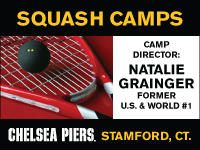Loving (Squash) Statistics...
by Bob Hanscom

March 26, 2012 - I love statistics! Why...because they're real and don't lie! There's no room for interpretation, judgement or human error! “The proof is in the pudding,” as they say.
For example, for over 30 years - from 1967 to 1997, the men's game of squash was dominated by only FOUR players: Jonah Barrington six years; Geoff Hunt eight years; Jahangir Khan ten years; Jansher Khan six years.
The next 14 years saw EIGHT different players dominating, which shows the increase in depth at the professional level: Jonathon Power (1998); Peter Nicol (1999), David Palmer (2002, 2006), and Thierry Lincou (2004). Amr Shabana is the most successful player after the above retired (2003, 2005, 2007, 2009) and Egyptian Ramy Ashour (2008), and the first Englishman and the champions after Nicol, who was a double world open champion - Nick Matthew (2010, 2011) and James Willstrop in 2012.
And...no one should forget the great Jahangir Khan who, between 1981 and 1986, was unbeaten in competitive play for over five years. During that time he won 555 games consecutively, the longest winning streak by any athlete in top-level professional sports, as recorded by the Guinness World Records. Is the IOC listening!?
And of course for the women, before the creation of the Women's World Open, enaugurated in 1979, who can forget Heather McKay, with her lengthy and absolute dominance of the game, remaining undefeated for 18 years during the 1960s and 70s, arguably the greatest woman player of all time.
Since then, which is considered by most to now be the “modern era,” Susan DeVoy of New Zealand holds the all-time record for being the #1 player in the world, achieving 105 total months (58 unbroken) at the top until 1993. Currently, Nicol David, the six-time world champion record-holder, is second on the list, chasing DeVoy with 71 total months at #1, (68 unbroken) needing 34 more months as #1 to catch and surpass DeVoy. Any bets on that happening? Barring injury or her choice, my money is on Nicol in accomplishing that goal.
Although we wouldn't ordinarily think of it as “statistics,” the world professional “ranking” system is based on “statistical” results of match-play. After all, how else would an accurate accounting of rankings be formulized other than gathering information from match-play results - and awarding appropriate ranking points based on prize money earned.
More interesting stats - just this past weekend, Nick Matthew overcame James Willstrop in the final of the Canary Wharf event in three straight games, 11/7, 11/8, 11/9, which took 78 minutes. On their way to and including the final, Matthew played 15 games for a total of 296 minutes, or an average of 19.73 minutes per game. Willstrop played 17 games for a total of 288 minutes, for an average of 16.94 minutes per game. Although playing two additional games, Willstrop played eight less total minutes. Interesting? I think so!
And...in the final match of the event, a total of 27 Lets were awarded, 10 in the first and second, 7 in the third game - for an average of 9 Lets per game! Of course there were appeals and Strokes awarded, but I find it quite ineresting that a match, (played by the current top two players in the world), would have so many Lets awarded.
We'll take for granted that each of the two players were making every effort to get to the ball. So...exactly what were the situations deserving “Let” calls?” It seems that if the outgoing player was unsuccessful in clearing a direct path to – or a full swing at the ball, a call of “Stroke” would have been more often appropriate.
Of course, we didn't see the match, so we'll have to depend on our imagination (not statistics) as to what the appropriate “calls” should have been. Back to the real and accurate world – show me the statistics!
Back To Main


